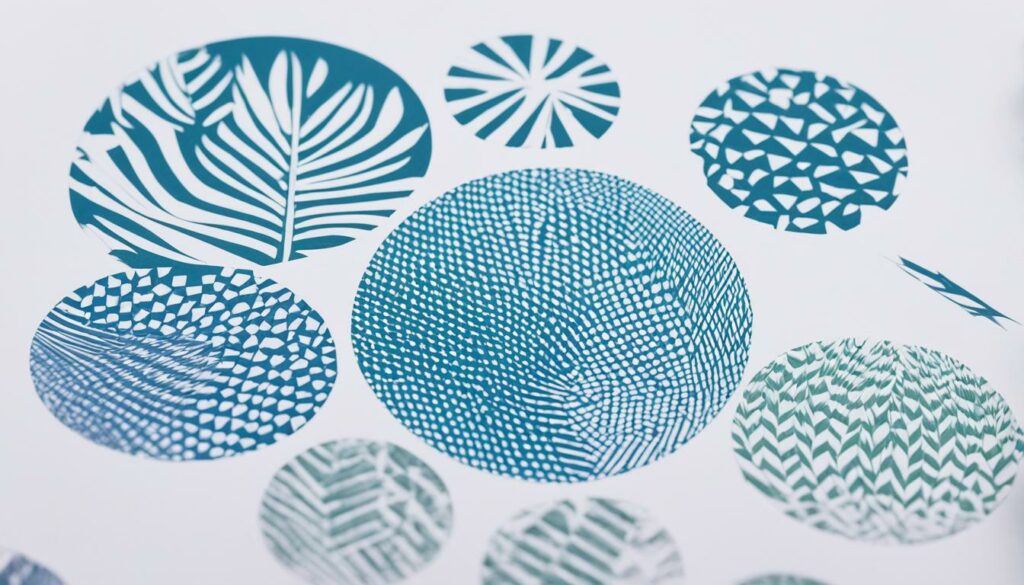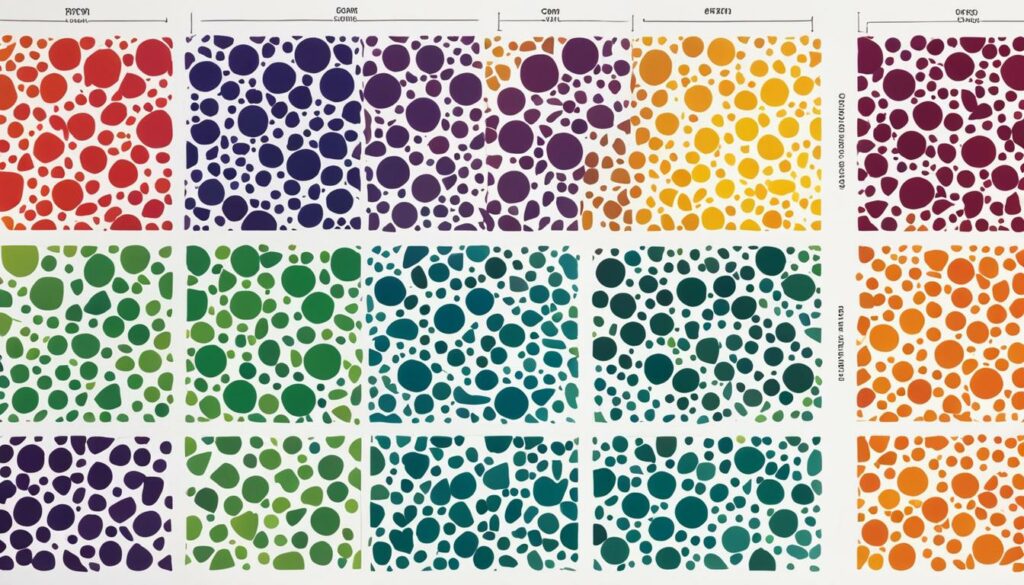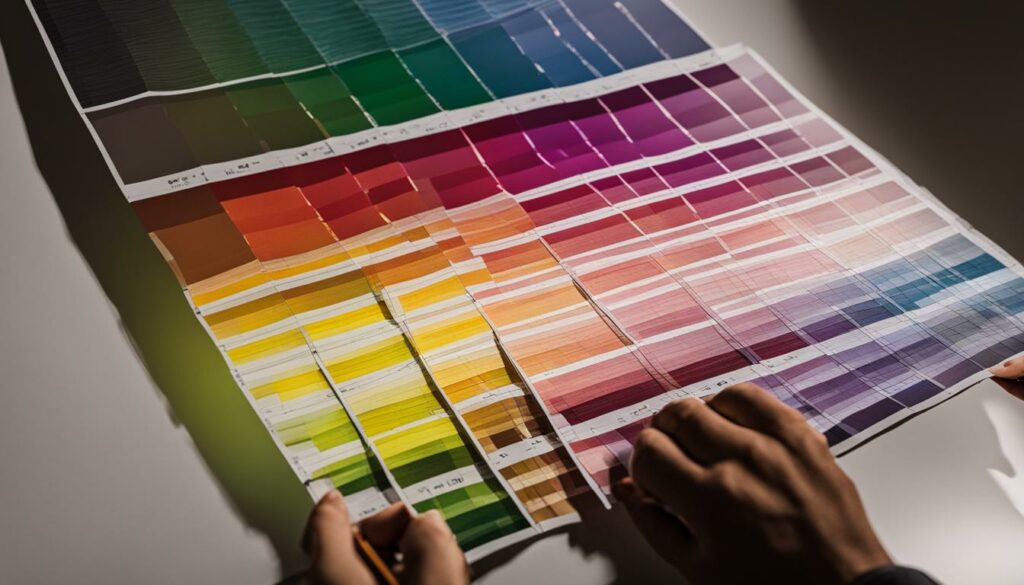A print test may seem like a simple concept, but it holds great significance in the world of printing. In this section, we will explore the meaning of print test and its importance in ensuring top-notch print quality.
A print test is essentially a method of evaluating the quality, accuracy, and consistency of printed materials. By conducting a print test, businesses can identify potential issues early on and make necessary adjustments, resulting in high-quality print outputs that meet customer expectations.
In the following sections, we will provide a comprehensive overview of print tests, encompassing their purpose, process, and relevance in different industries. We will delve into the types of print tests, how to conduct one effectively, and best practices to follow. Additionally, we will analyze case studies that demonstrate the effectiveness of print testing and explore technological advancements in the field.
Key Takeaways
- A print test is a method of evaluating the quality, accuracy, and consistency of printed materials.
- Conducting a print test can identify potential issues early on and lead to high-quality print outputs.
- Print tests are relevant in various industries, and different types of tests are used depending on the printing process and requirements.
- Best practices, such as test frequency and documentation, should be followed to ensure optimal print quality and consistency.
- Technological advancements have enhanced the efficiency and accuracy of print tests.
What is a Print Test?
A print test is a process used to evaluate the quality, accuracy, and consistency of printed materials. It is an essential tool in ensuring that printing outputs meet the required standards and expectations in different industries.
During a print test, various parameters are evaluated, including color accuracy, print resolution, and overall print quality. The test involves printing a sample of the material and analyzing it to identify areas that require improvement.
In short, a print test is a quality control measure that allows businesses to ensure that their printed materials are of high quality and consistency, meeting the expectations of their target audience.
Parameters Evaluated During a Print Test
There are several parameters that are evaluated during a print test to ensure high-quality and consistent outputs:
| Parameter | Description |
|---|---|
| Color accuracy | The degree of similarity between the intended and printed colors. |
| Print resolution | The sharpness and clarity of printed images and text. |
| Paper quality | The thickness, weight, texture, and other features of the printing paper. |
| Ink adhesion | The ability of ink to adhere to paper or other printing surfaces. |
| Print alignment | Ensuring that the printed materials are correctly aligned, avoiding issues such as smudging or overlapping. |
In conclusion, a print test evaluates various parameters such as color accuracy, print resolution, paper quality, ink adhesion, and print alignment, ensuring high-quality and consistent outputs. By conducting print tests regularly, businesses can improve the accuracy and reliability of their print outputs, leading to increased customer satisfaction and loyalty.
The Importance of Print Tests
Print tests are an essential part of ensuring high-quality print outputs. By conducting regular print tests, businesses can identify potential issues early on and make necessary adjustments, resulting in improved print quality and higher customer satisfaction.
One of the most critical benefits of print tests is the ability to detect and correct print-related issues before distributing printed materials to customers. These issues include inconsistencies in color, clarity, and alignment, which can significantly impact the quality of print outputs.
Moreover, conducting print tests enables businesses to establish and maintain high-quality print standards, ensuring consistency across all printed materials. This level of consistency is essential in creating a professional image and reputation that instills confidence in consumers.
Without print tests, businesses run the risk of delivering subpar print outputs, leading to customer dissatisfaction and even damage to their brand's reputation. By making print tests a regular part of the printing process, businesses can significantly reduce these risks and consistently deliver high-quality print outputs.
Overall Benefits of Print Tests
- Improved print quality and consistency
- Early identification and correction of potential issues
- Establishment of high-quality print standards
- Enhanced brand reputation and consumer confidence
Types of Print Tests
In the world of printing, different types of print tests are used to ensure the accuracy and quality of printed materials. These tests are crucial for identifying potential issues early in the printing process, leading to improved print quality and customer satisfaction.
Color Print Tests
One of the most common types of print tests is a color print test, which is used to evaluate color accuracy and consistency. This test involves printing a color chart that includes various shades of primary, secondary, and tertiary colors. The chart is then compared to a standardized color chart to identify any discrepancies in color accuracy and consistency.

Registration Tests
Another type of print test is a registration test, which measures the alignment accuracy of printed elements. This test is important in ensuring that all the components of a printed piece are properly aligned with each other. The test involves printing a registration mark on the material and comparing it to the original artwork to identify any discrepancies.
Other Specific Print Tests
In addition to color and registration tests, there are other specific print tests that can be performed depending on the printing process and requirements. These tests may include ink adhesion, image resolution, and print durability tests, among others.
Conducting a Print Test
Conducting a print test is an essential aspect of ensuring high-quality print outputs. Follow these step-by-step guidelines to conduct a print test effectively:
- Prepare the Required Materials: The necessary materials for a print test include a printer, the print test file, and the chosen substrate or paper.
- Set Up the Equipment: Ensure that all equipment and software are functioning correctly and calibrated appropriately for the substrate.
- Adjust the Printer Settings: Adjust various printer settings, including print speed, resolution, and color values, depending on the substrate and print test objectives.
- Print the Test File: Print the test file onto the chosen substrate, ensuring you adhere to best practices of print quality settings and use the proper color profile.
- Analyze the Results: Once the print test is complete, check the resulting output for quality issues, including misprints, color variation, and any defects.
- Interpret the Results: Review and understand the results of the test. Understand if more adjustments are needed to achieve the desired quality output.
To gain the most accurate and reliable print test results, it's essential to follow best practices, including test frequency, documenting each test, sample size, and collaboration with print suppliers to ensure optimal print quality.
It's possible to identify and rectify any quality issues that may affect the accuracy and consistency of printed materials by conducting a print test effectively. By following these steps, you can ensure accurate and reliable print tests, resulting in positive business outcomes and satisfied customers.
Interpreting Print Test Results
After conducting a print test, the next step is interpreting the results. This involves analyzing the outcomes of the test to identify areas that require improvement or adjustment.
One key factor to consider when interpreting print test results is the established print industry standards. These standards provide guidelines for print quality and consistency and help ensure that printed materials meet the required specifications.
When reviewing print test results, it is essential to pay attention to the following parameters:
- Color accuracy
- Registration and alignment
- Sharpness and detail
- Tonal range and gradation
Based on the test results, adjustments can be made to correct any issues or maintain high-quality print outputs.
Tip: Use a color measurement tool to obtain objective data on color accuracy, ensuring more precise interpretations of print test results.

Interpreting Color Accuracy
Color accuracy is a critical aspect of print quality and is evaluated using various metrics such as Delta E and CIELAB. Interpreting color accuracy results involves comparing the measured colors to the intended hues and identifying any deviations. Alternatively, visual assessments can also be used to evaluate the color accuracy of printed materials.
Interpreting Registration and Alignment
Registration and alignment are evaluated by comparing the locations of printed elements and checking for any offsets or discrepancies. Print test results can help identify registration or alignment issues and assist in making necessary adjustments.
Common Challenges in Print Testing
Despite its importance, print testing can present certain challenges that must be dealt with effectively. Below are some of the most common print testing challenges that businesses encounter:
| Challenge | Solution |
|---|---|
| Color consistency | Use color calibration tools and ensure consistent lighting during testing |
| Print misalignment | Ensure proper registration and alignment of printing equipment before testing |
| Equipment and material variations | Regularly maintain and calibrate printing equipment, and use standardized materials for testing |
In addition to these challenges, other factors such as print quality inconsistencies and operational errors can also affect the accuracy of print testing results. It is crucial to identify and address these issues promptly to ensure optimal print quality and customer satisfaction.
To overcome these challenges, businesses can implement certain best practices during print testing. These include employing standardized testing protocols, using high-quality testing equipment, and ensuring proper maintenance and calibration of printing equipment. These measures can enhance the efficiency and reliability of print testing, mitigating common challenges that may arise.

Emphasizing Accuracy in Print Testing
One of the most critical aspects of print testing is maintaining accuracy and consistency. To achieve this, businesses must be aware of the challenges that can arise during testing and take necessary measures to address them effectively. By employing best practices and leveraging the latest advancements in print testing technology, businesses can ensure that their printed materials meet the highest quality standards.
Print Testing in Different Industries
Print testing is a crucial quality control process that is utilized by various industries to ensure their printed materials meet specific requirements and standards. Let's take a look at how different sectors utilize print tests:
Publishing
The publishing industry prints books, magazines, and newspapers at a large scale. A print test helps ensure that the printed materials being mass-produced meet the high-quality standards expected by readers. Print tests identify potential issues with color consistency, text alignment, and image clarity, among other aspects important to readers and industry professionals.
Packaging
The packaging industry relies heavily on print tests to ensure that their designs are printed to accurate specifications. Print tests ensure the packaging design is correctly printed in terms of color, size, and placement to maintain branding and marketing strategies.
Advertising
High-quality print materials are essential for the advertising industry to attract customers and convey their message effectively. Print tests are conducted to ensure the accuracy and consistency of print outputs and detect any errors or defects before they reach consumers.

Print testing is crucial to the success of different industries, as it helps maintain quality standards and boosts customer confidence. Regardless of the sector, each industry must maintain the highest quality standards for maximum consumer satisfaction.
Advancements in Print Testing Technology
As technology continues to evolve, the field of print testing has seen significant advancements in recent years. The use of advanced print testing equipment, software, and automation has revolutionized the efficiency and accuracy of print tests.
One such advancement is the utilization of digital presses, which enable the creation of custom color tables and profiles for more precise color matching. Additionally, the use of spectrophotometers and color measuring instruments has allowed for more accurate color analysis and color management.
Automation has also played a key role in improving print testing efficiency. Automated workflows and robotic systems have streamlined the testing process, reducing the time and cost associated with manual testing. Moreover, the integration of print testing software with other business systems has enabled seamless data analysis and reporting.
Going forward, it is expected that print testing technology will continue to advance, with increased focus on sustainability and environmental consciousness. This will include advancements in materials and processes that reduce waste, as well as the use of digital tools for remote testing and collaboration.

Best Practices for Print Testing
Conducting print tests is an essential step towards achieving high-quality print outputs. However, to ensure accurate and reliable results, it is crucial to follow best practices. Here are some key factors to consider:
Test frequency
- Regularly conduct print tests, particularly when implementing new printing equipment or processes.
- When testing, use fresh ink and paper materials to avoid inconsistencies.
- Consider testing batch samples for better accuracy and representativeness.
Sample size
When conducting print tests, it is important to have an adequate sample size to achieve a comprehensive understanding of print quality across different parameters.
| Sample Size | Best Used For |
|---|---|
| 1-10 prints | Quick checks, troubleshooting specific issues, or spot color matching |
| 11-50 prints | Evaluating color consistency or print consistency across multiple prints |
| 51+ prints | Thorough analysis of print quality across all parameters and identification of trends or patterns |
Documentation
- Document the results of each print test, including the date, equipment, materials, and tested parameters.
- Use this documentation to track progress and identify areas for improvement over time.
- Share this documentation with print suppliers to enhance communication and collaboration towards optimal print quality.
Collaboration with print suppliers
Collaborating with print suppliers can enhance the quality of print testing results as print suppliers have industry knowledge to ensure printed materials are of the right quality.
By following these best practices, you can optimize your print testing process to achieve superior quality and consistency in your printed materials.

Print Test Case Studies
Real-world examples provide compelling evidence of the importance and effectiveness of print tests. In this section, we have gathered a few case studies that illustrate how print testing has helped companies achieve their quality objectives and improve customer satisfaction.
Case Study #1: XYZ Corporation
“We were experiencing quality issues with our packaging labels, but we couldn't pinpoint the root cause. Conducting a print test helped us identify that the ink we were using was not suitable for the label material, resulting in poor adhesion and readability. We were able to switch to a more suitable ink, and the subsequent print tests showed improved outcomes. We have now implemented regular print testing as part of our quality assurance program.”
– John Smith, Director of Quality Control at XYZ Corporation
Case Study #2: ABC Publishing
| Issue | Before Print Testing | After Print Testing |
|---|---|---|
| Inconsistent color | 50% of prints failed color matching standards | 100% of prints met color matching standards |
| Printing defects | 3-4 defects per 100 prints | No defects found |
| Customer complaints | 10-15% of books returned due to print quality | Less than 5% of books returned due to print quality |
ABC Publishing had been receiving numerous complaints from customers about the quality of their printed books. By conducting a print test, they were able to identify issues with color consistency, printing defects, and other quality problems. They implemented corrective actions and continued to test regularly, resulting in significant improvements in print quality and customer satisfaction.
Case Study #3: DEF Advertising
“We were able to save thousands of dollars in marketing materials by conducting print tests and making necessary adjustments early on in the process. By catching issues before mass printing, we avoided costly reprints and decreased the time to market.”
– Sarah Lee, Marketing Manager at DEF Advertising
DEF Advertising learned from their mistakes and integrated print testing as a standard practice in their marketing promotions. Regular print tests helped them identify issues early on, enabling timely and cost-efficient corrections.
As the above case studies exemplify, print tests are crucial for ensuring quality and identifying issues early in the printing process. By conducting regular print tests, businesses can save time and money, improve customer satisfaction and loyalty, and maintain their professional reputation.
Conclusion
In conclusion, print testing is a crucial process for ensuring high-quality print outputs that meet customer requirements and expectations. By conducting print tests, businesses can identify and rectify potential issues early on, resulting in improved print quality and customer satisfaction.
It is essential to follow best practices when conducting print tests, such as establishing a proper test frequency, sample size, and documentation. Collaboration with print suppliers and leveraging advancements in print testing technology can further enhance the effectiveness of these tests.
Real-world case studies demonstrate the effectiveness and benefits of print testing. By implementing this guide's recommendations, businesses can optimize their print quality, reduce cost, and enhance their customers' experience.
Thank you for reading this comprehensive guide on print testing, and we hope it helps you achieve optimal print quality and customer satisfaction.
FAQ
What is a print test?
A print test is a method used to assess the quality, accuracy, and consistency of printed materials. It evaluates various parameters to ensure high-quality print outputs.
Why are print tests important?
Print tests are important because they help identify and rectify potential issues early on, leading to improved print quality and customer satisfaction.
What are the types of print tests?
There are different types of print tests, including color print tests, registration tests, and other specific tests depending on the printing process and requirements.
How do I conduct a print test?
To conduct a print test, follow a step-by-step guide that includes gathering the necessary equipment, materials, and variables for testing. It is also important to follow best practices for accurate and reliable results.
How do I interpret print test results?
To interpret print test results, carefully analyze and evaluate the outcomes. Look for areas that require improvement or adjustment, and consider print industry standards for a reliable interpretation.
What are common challenges in print testing?
Common challenges in print testing include color consistency, print misalignment, and other factors that may affect the accuracy of test results. Tips and solutions are provided to overcome these challenges.
How is print testing applied in different industries?
Print testing is applied in various industries, such as publishing, packaging, and advertising, to meet specific requirements and quality standards.
What are the advancements in print testing technology?
Advancements in print testing technology include the use of advanced equipment, software, and automation, which enhance the efficiency and accuracy of print tests.
What are the best practices for print testing?
Best practices for print testing include factors like frequency of testing, sample size, documentation, and collaboration with print suppliers to ensure optimal print quality and consistency.
Can you provide print test case studies?
Yes, we have real-world case studies that demonstrate the effectiveness and benefits of print testing. These examples highlight how print tests can identify and resolve quality issues, resulting in improved customer satisfaction and cost savings.

I'm Morgan, the creator of VPNForMe — a site born from too many hours spent side-eyeing sketchy VPN reviews and buffering videos.
I wanted a place where people could get straight answers about privacy, streaming access, and which VPNs actually deliver — without the hype or tech jargon.

